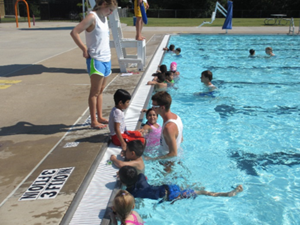Summer is here and many families will beat the heat by spending time in the pool. Special attention must be paid to children’s safety around swimming pools. According to the Red Cross, more than 200 young children drown in backyard swimming pools each year.
The following information from http://www.safekids.org/tip/swimming-safety-tips, http://www.redcross.org/prepare/disaster/water-safety/home-pool-safety and http://www.poolsafely.gov will help to ensure a safe, fun summer.
- Actively supervise children around water at all times and stay close to them.
- For very young children, an adult should be in pool with them and within arm’s reach. Pay constant attention to older children.
- When several adults are present, use the Water Watcher card strategy, which designates an adult as the Water Watcher for a certain amount of time to prevent lapses in supervision. Download a Water Watcher card here.
- Inexperienced swimmers should wear Coast Guard approved life jackets. Water wings, water noodles, etc. are toys – not safety items.
- Make sure swimmers are told to walk, not run; swim with a buddy; and stay away from drain covers.
- Have and enforce a no diving rule if water isn’t deep enough. Do not allow diving into above ground pools or the shallow end of pools.
- Teach children to always ask permission to go near water.
- Surround pool with a 4’ high fence or barrier with self-closing, self-latching gate. Do not use any type of climbable barrier.
- Keep lawn furniture away from the fence as it can be used to climb fence. Also be sure that there are no spaces in the fence through which children can enter.
- Cover pool or hot tub when not in use and remove steps and ladders.
- Consider adding an alarm that sounds when someone enters the pool.
- Consider installing alarms on doors and windows in case children go outside without adult supervision.
- Ensure everyone in the home knows how to swim by enrolling them in age-appropriate water orientation and learn-to-swim courses.
- Perform regular maintenance on pools and hot tubs.
- Take toys out of the water when not in use and do not allow the use of riding toys near the pool. Do not allow electrical appliances near the pool.
- Empty blowup pools after use.
- Be sure that everyone knows how to react to emergencies and has taken CPR classes.
- Children should learn to swim between the ages of 1 and 4. All children are different so there isn’t an exact age. Consider emotional maturity, physical limitations and health concerns when thinking about swimming lessons. Be aware that swim lessons do not prevent drowning.
- Know how to respond to an aquatic emergency. If a child is missing, check the water first. Seconds count in preventing death or disability. Know when to call 9-1-1 or the local emergency number.
- Have appropriate equipment, including reaching or throwing equipment, cellphone, life jackets and a first-aid kit, near the pool.


